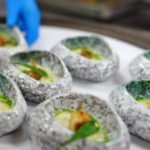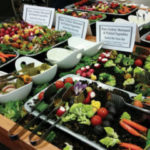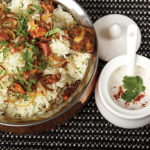If you compiled a list of food-forward cities, Providence, Rhode Island, would rank pretty high. Many of the students at the city’s Johnson & Wales University, one of the country’s pre-eminent culinary-arts and hospitality schools, stay in town to open their own eateries, helping make Providence’s dining scene one of the best in the United States. So eating in Providence for a few days (as Convene did last month during a press trip sponsored by Go Providence, the city’s CVB) can offer a solid glimpse into what’s trending in the world of food and beverage — and most everyone in Providence has an opinion. “Bao,” said Michael Canini, general manager of the Renaissance Providence Hotel and a Johnson & Wales graduate, referring to Chinese-style stuffed, steamed buns. (A second location of Tom’s BaoBao, a popular Boston spot planning an East Coast rollout in com-ing years, just opened in Providence.)
“Seasonal and local food,” said another J&W graduate, Edward Bolus, executive chef at Mill’s Tavern, fully aware that his answer was “not that exciting.” Still, Bolus sees diners increasingly craving flavors that link to place or season, such as the tomato jam he makes from his own late-season tomatoes and serves alongside house-cured salmon, or the Littleneck clams he braises in a broth made from local lager. At the end of each year, it’s fun to predict what might lie ahead. So here are five more trends for F&B — drawn from recent press trips, food-forward events, and dining out — that meeting professionals might keep an eye on during 2017.
1. “TRASH” FISH DISHES
For Kristen Adamo, vice president of marketing and communications for Go Providence (who, yep, used to work at Johnson & Wales), this was the first trend that sprung to mind — specifically, the use of scup, aka porgy, in local Providence restaurants. Chefs have certainly been proactive about using castoffs such as carrot tops and water-melon rinds in gourmet dishes, but they’ve been slower to warm to bycatch and other fish that aren’t commonly served, such as mackerel and rockfish. Perhaps they don’t want to end up with uneaten seafood from diners too nervous to order sautéed scup.

When it comes to catering, however, 2017 may be the year that diners finally come face-to-face with the escalating prices and scarcity of overfished sea bass and cod, and embrace dishes such as sardine toast points and crispy tile-fish. At Google’s New York headquarters earlier this year, for example, chef Michael Wurster created a “surf-over-turf” burger made from “underloved” fish such as bluefish and skate. And the “Trash Fish Dinners” of Boston’s Chefs Collaborative have taken off — and are a great source for dish ideas such as pulled amberjack over corn cakes.
2. LATIN AMERICAN STREET FOOD
Once food trucks were the trend — and now the quick-and-unfussy plates they serve have migrated back into brick-and-mortar establishments. Hollywood, Florida’s Diplomat Beach Resort held a party in New York City in October to preview its upcoming $100-million renovation, an event that showed off dishes from new restaurants such as Playa, a “Nuevo Latino” concept from chefs Sue Torres and Darren Carbone. On their menu: pupusas, which are El Salvadoran–style tortillas filled with lamb picadillo; chicken-tinga arepas, which are griddled corn cakes; and grilled corn smothered in tarragon aioli. Sure, the Diplomat is in Florida, but these imaginative, two-bite hand foods are ideal for creative receptions and events — and they draw on super-fresh ingredients, from shrimp and cheeses to herbs and salsas.
3. PAN-ASIAN BAR FOOD
In Japan, it’s izakaya; in Korea, anju; in China, dim sum. What do they describe? Savory, shareable snacks intended to accompany drinking (or just the pre- or post-dinner hour). Asian bar food is proliferating in North America — and although crispy, grilled-chicken-skin skewers might be too outlandish for some palates (these are served at another Providence favorite, Ebisu), plates such as barbecue-pork puffs and edamame dumplings are ideal accompaniments to alcohol during evening receptions.
4. TEMPORARY FOOD HALLS
In the last few years, dozens of new food halls have opened in North America, catering to our current obsession with fast, unfussy food. Now, our craving to be in the know, Instagram our food, and grab dishes before they’re gone is fueling both fine-dining popups and temporary food halls. New York City’s Grand Central Station currently houses a lauded yet temporary Nordic food hall called Great Northern, while San Fran-cisco has a bustling spot called The Hall. If you’ve noticed the shift from passed apps to upscale food stations at receptions, know that it’s being followed by another evolution — food stations that are branded to look more like temporary outposts of a mother restaurant, complete with larger portions and accompanying beverages. Arrange a few of these stations in a certain way, and you have a popup food hall.
5. ICE-CREAM EVERYTHING
Ice cream never really goes out of style, but it’s migrating to places and evolving into forms you might not expect. Thai-style rolled ice-cream shops have been popping up around the United States, affogato (hot espresso poured over ice cream) has been showing up at private events, and soda floats and savory sundaes are invading dessert menus. In Austin, Texas, an alcoholic ice-cream shop called Prohibition Creamery opened earlier this year — demonstrating that ice cream can be really, really grown up.





